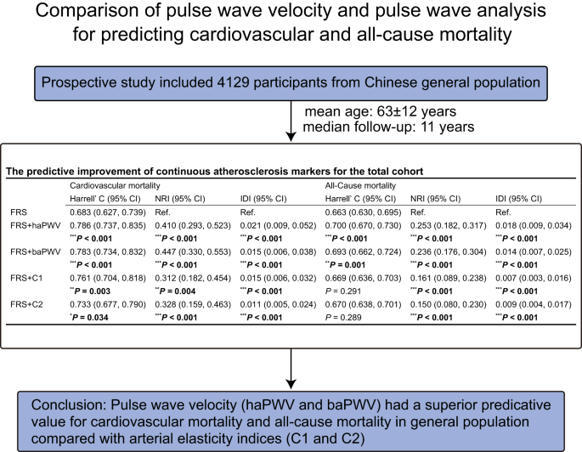Comparison of arterial stiffness indices measured by pulse wave velocity and pulse wave analysis for predicting cardiovascular and all-cause mortality in a Chinese population | Hypertension Research

La quantification des inégalités de santé – Enjeux théoriques et méthodologiques | Recherche | Cnam
05/02/2024You Are What You Eat: A Twin Experiment – Wikipedia
19/02/2024
Arterial stiffness measured by pulse wave velocity and pulse wave analysis has been widely studied in different populations in terms of its correlation with cardiovascular events and all-cause mortality. It remains unknown which arterial stiffness index is better for risk stratification in the general population. We included 4129 participants from Gaoyou County, Jiangsu Province, China, with a median follow-up of 11 years. The primary endpoint was cardiovascular mortality, and the secondary endpoint was all-cause mortality. Harrell’s C-index, net reclassification improvement (NRI) and integrated discrimination improvement (IDI) based on the Cox proportional hazards regression model were evaluated to assess predictive discrimination and accuracy. The associations between the 4 indices and cardiovascular mortality remained significant after adjusting for the Framingham Risk Score (FRS) and/or associated risk factors. Considering reclassification based on the newly integrated models (FRS model combined with the 4 indices), NRI for cardiovascular mortality showed that haPWV and baPWV had more significant improvement in reclassification compared with C1 and C2 [NRI with 95% CI: haPWV 0.410 (0.293, 0.523); baPWV 0.447 (0.330, 0.553); C1 0.312 (0.182, 0.454); C2 0.328 (0.159, 0.463); all P < 0.05]. This study showed that pulse wave velocity (haPWV and baPWV) provides better discrimination of long-term risk than arterial elasticity indices (C1 and C2) in the general population.
Lire l’article complet sur : www.nature.com



